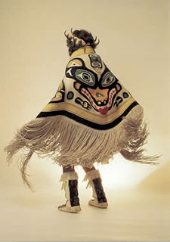posted 12 years ago
Hi Dennis,
These are great questions, and I love that you have been working with tanning salmon skins I'd love to know more. I've dabbled in brain and bark tanning, but this is not my area of expertise so I can only offer some rather random, general information, but hopefully helpful.
There are lots of references to Western hemlock bark and alder being used to for tanning, as well as to dye fish nets. Recently I've learned that tanning fiber cordage nets helps to preserve them in salt water so I imagine that played as much of a role in the decision to do this as dying them so that fish couldn't see them (which is the reason that is most often given). As for the use of tanned hide for clothing in Western Washington, you are asking a much debated question. However, I live and work with the Snoqualmie Tribe, an upriver people, and by most accounts the use of elk hide clothing was definitely in general use, and is used today in the tribal regalia. I did a fair amount of research on this for my book, and include drawings of clothing with the use of hide and fur for men and women daily wear. The Snoqualmie were major hunters and gatherers traveling up into the mountains and over the mountain passes, so the use of hide clothing for leggings, tunics and moccasins makes sense. Early records give details about the construction of these moccasins specific to the upriver tribes so I believe this was definitely the case. These records also give specifics about where the fringe on tunics was located etc. I also discovered references to the use of strips of tanned hide with fur on being used to create vests and cloaks. Processed skins of smaller animals were cut into strips which naturally twisted, and these were twined into vests and capes worn by women with soft fur inside and outside these garments. Luxurious! I've always wanted to reconstruct one of these. Hunters were known to wear entire hides such as deer, cougar or bear with fur on while hunting, and I see this today sometimes as regalia. Favored children were given garments from hide made from fawns with spots still on, and hats made from raccoon skins and other small animals. I agree that it makes the most sense that these hides were tanned with bark rather than brain. But other protein such as fish egg might have also been employed.
I'm very intrigued by your tanned salmon skins. Early explorer accounts make note of the excellence of the bows in this area (I include some quotes from these journals in the book), and of particular note was the serpent skinned backing used on the bows which apparently helped to make them waterproof. They were affixed with a glue that was not affected by the rain, and all of this contributed to the bows being effective even when it was raining. I've often wondered if the serpent skin wasn't fish skin, though there are plenty of snakes in the area that could certainly have been used.
I'm sure there is more to add, but off the top of my head this is what comes to mind. Thanks for the good questions and I hope to hear more of what you are doing. Sounds fun.
Heidi Bohan, Ethnobotanist, educator, author- People of Cascadia, Starflower Native Plant ID Cards; Skills based mentorship programs









